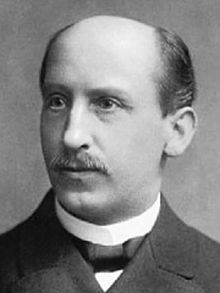Ludwig Claisen
Ludwig Rainer Claisen (born January 14, 1851 in Cologne , † January 5, 1930 in Godesberg , today Bonn ) was a German chemist .
life and work
Ludwig's father was a respected judiciary and notary in Cologne. With his brothers he attended an old-language, catholic high school in Cologne, which he left with the Abitur in 1869. He studied chemistry from 1869 to 1871 at the University of Bonn under Theophil Engelbach, and from 1871 to 1873 under Hans Huebner , Friedrich Wöhler and Bernhard Tollens in Göttingen . After graduating as Dr. phil. in 1875 with the work Contributions to the knowledge of mesityl oxide and the phoron in Bonn at August Kekulé , he first became his assistant.
In 1878 he completed his habilitation there and was then taken on as a private lecturer . From 1881 Claisen dealt with the conversion of malonic acid esters with ketones . Later he and his students investigated the conversion of acetoacetic ester with ketones and aldehydes .
For a few years he went to Owens College in Manchester and then to Munich as an employee of Adolf von Baeyer . In 1890 he followed a call to RWTH Aachen University , where he was appointed full professor of chemistry for the main areas of work: synthetic organic chemistry and tautomeric phenomena (Claisen's oxygen- allyl , carbon- allyl rearrangement ) . In 1897 moved to Claisen University of Kiel , where he in 1902 for health reasons initially given emeritus status , but moved for some time to the University of Berlin was in 1904, around there's begun research on the effect of sodium amide complete with condensation. After that, he finally moved back to the Rhineland, where he still ran a private laboratory.
In 1877 his work, Studies on Organic Saurecyanides, appeared . In this work the easy convertibility of benzoyl cyanide to benzoyl formic acid and acetyl cyanide to pyruvic acid was shown. In his habilitation thesis , a representation of Isatin , a preliminary stage of indigo , was shown.
In 1881 he discovered the Claisen condensation of carboxylic acid esters, which is named after him, and the Claisen-Tiščenko reaction for the production of carboxylic acid esters from aldehydes . In his retirement he discovered the Claisen rearrangement, also named after him, of phenyl allyl ethers into o-allyl phenols.
Ludwig Claisen was a member of the Bavarian Academy of Sciences as well as an honorary member of the Association of German Chemists and was awarded a Dr. Ing. E. h. appointed by RWTH Aachen. In 1881 he was elected a member of the Leopoldina .
Several laboratory devices are named after him, the Claisen bridge , a distillation bridge which, in addition to an opening for a thermometer, contains another opening for a boiling capillary , sometimes also designed as a so-called Claisen attachment that does not contain a cooler and the Claisen flask with a Claisen attachment is combined with a piston (mostly designed as a pointed piston ).
literature
- Ludwig Anschütz : Claisen, Ludwig. In: New German Biography (NDB). Volume 3, Duncker & Humblot, Berlin 1957, ISBN 3-428-00184-2 , p. 257 f. ( Digitized version ).
Web links
- Portrait ( Memento from May 26, 2011 in the Internet Archive )
- Christian-Albrechts-Universität zu Kiel : Short biography of Ludwig Claisen
- www.habenlexikon.net: Ludwig Claisen
Individual evidence
- ↑ Life data, publications and academic family tree of Ludwig Rainer Claisen at academictree.org, accessed on January 28, 2018.
| personal data | |
|---|---|
| SURNAME | Claisen, Ludwig |
| ALTERNATIVE NAMES | Claisen, Ludwig Rainer (full name) |
| BRIEF DESCRIPTION | German chemist |
| DATE OF BIRTH | January 14, 1851 |
| PLACE OF BIRTH | Cologne |
| DATE OF DEATH | 5th January 1930 |
| Place of death | Godesberg , today Bonn |
